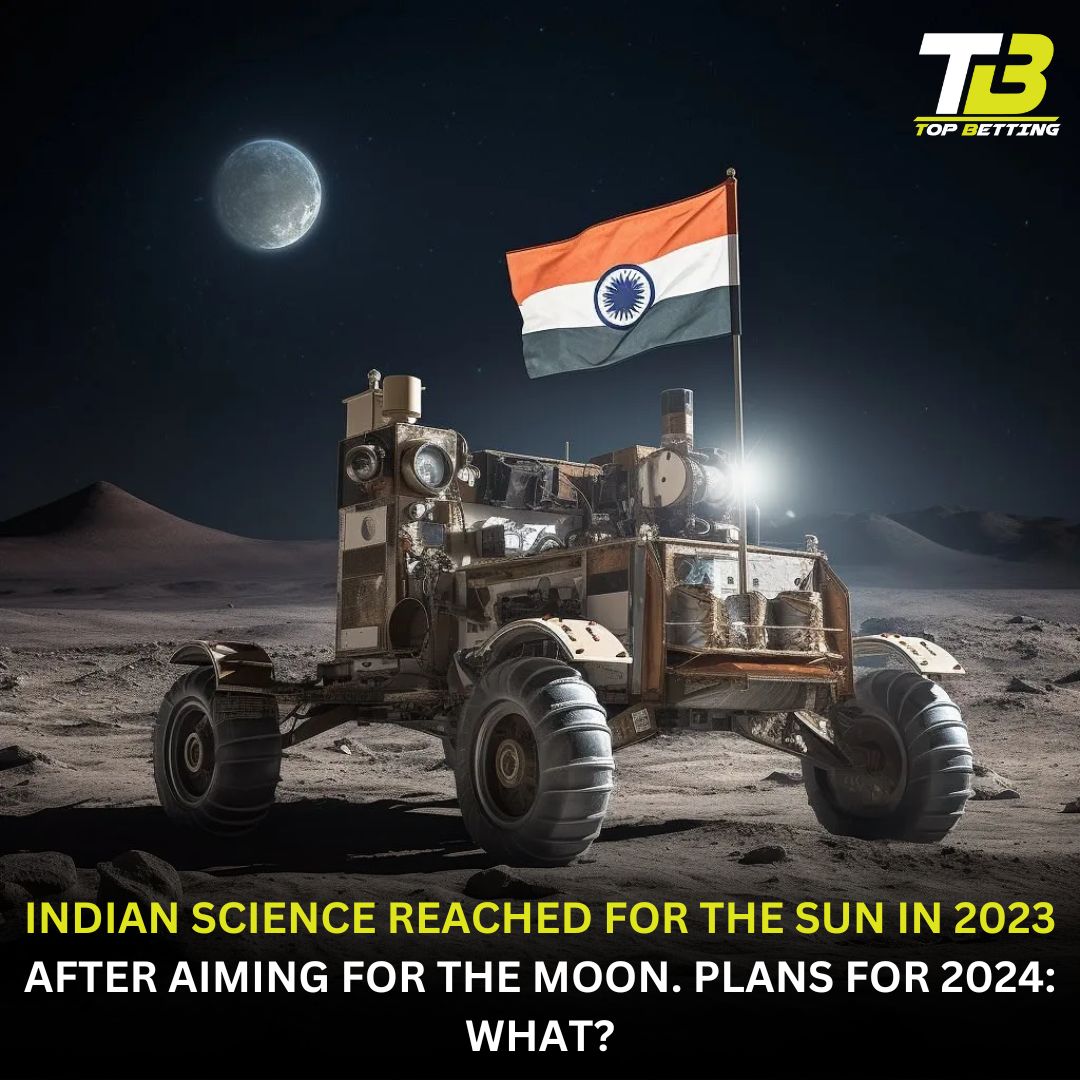
What is aim of indian science in 2024 | The Next resolution
The Moon landing stretched boundaries both on Earth and in space, making it the greatest scientific achievement for India in 2023. What major plans do you have for 2024?
Even if the Moon landing was unquestionably the pinnacle of Indian science in 2023, the country’s space program saw a significant transition that year. The Indian Space Research Organisation (ISRO) made significant advancements in its transition from a satellite launch and orbital placement organization to a full-fledged planetary exploration organization.
With seven successful missions completed, including the two well-known ones—Chandrayaan-3 and Aditya-L1, India’s first journey to the Sun—this was one of ISRO’s most active years. The Covid epidemic appeared to have severely affected the space agency’s timetable, impacting even the human spaceflight mission, Gaganyaan, which was initially scheduled for 2022. The year ended the agency’s reasonably frugal record. Gaganyaan is now slated for 2025, with a few qualifying exams to complete.
Meanwhile, ISRO has revealed an astounding list of goals it hopes to accomplish in the coming years, including putting a man on the moon by 2040, completing the space station Bhartiya Antariksh Station by 2028, sending an astronaut to the International Space Station in collaboration with NASA in 2024, and conducting Chandrayaan-4, a sample return mission from the Moon, in the following four years.
Apart from regular launches, there are also astronomical missions and exploratory missions to the Sun, Mars, and Venus.
Fresh Alliances
Increased international alliances were another outcome of ISRO’s expanding capabilities. India joined the US-led Artemis Accords for planetary exploration during Prime Minister Narendra Modi’s June visit to the US. Countries commit to upholding a set of values known as the Artemis Accords in their pursuit of cooperative and nonviolent lunar and extraterrestrial exploration. India’s decision to sign the Artemis Accords brings the two nations’ space programs closer together than before.
The agreement between ISRO and NASA to launch a collaborative mission to the International Space Station, a permanent laboratory approximately 400 km above the earth’s surface, in 2024, was another indication of the two organizations’ new, close relationship. In other words, Indian astronauts would reach space far before the Gaganyaan expedition in 2025.
A working group for commercial space collaboration was also established by the US and India later in the year, which is anticipated to help the nation’s private space sector. The two nations declared their determination to collaborate on planetary defense as well.
The National Institute of Research
The government intervened significantly to raise the quantity and caliber of scientific research conducted in the nation, even as ISRO was setting new standards in space exploration. The National scientific Foundation (NRF) was authorized by the government to support, encourage, and mentor scientific endeavors, fulfilling a pledge it made half a decade prior.
The NRF, which was modeled after the National Science Foundation in the US, would provide money for research totaling Rs 50,000 crore for the following five years. The NRF’s goal to strengthen research capacities at colleges and universities, however, has the most promise.
“In the nation, research and higher education have been artificially divided for some reason. There are colleges and universities where relatively little research is done, as well as research institutions. Increasing our universities’ capacity for research is one of NRF’s goals. The International Centre for Theoretical Sciences, a Tata Institute of Fundamental Research center located in Bengaluru, was founded by Spenta Wadia. “The union of education and research must be restored,” Wadia stated.
Finding answers to the major issues confronting Indian society is one of the main goals of the NRF, which would support research not only in the natural sciences and engineering but also in the social sciences, arts, and humanities.
Fresh Endeavors
India made significant decisions in the year to build up its own capabilities in cutting-edge scientific research fields. It initiated the Rs 6,000-crore National Quantum Mission in April with the goal of constructing a 1,000-qubit quantum computer in the following eight years. Not only can quantum computers operate at extremely high speeds, but they can also execute tasks that conventional computers would find difficult or impossible by utilising the quantum mechanical features of matter at a minuscule scale.
India may now participate in the worldwide race for technological advancement even if it is still in its early phases thanks to the National Quantum Mission launch. India has a lot of catching up to accomplish because it has frequently been a latecomer to such topics, such as the development of supercomputers. It also fails to take advantage of the spillover effects of technological advancement.
The approval of the LIGO-India project, which aimed to construct a gravitational wave observatory in Maharashtra, was another decision along these lines. Seven years prior, the project had been approved in principle, but the final approval didn’t come until April. The first gravitational wave detection was made in 2015 by LIGO-India, the third arm of two identical observatories in the United States; two years later, LIGO-India was awarded the Nobel Prize in Physics for this achievement. Another area where there are currently very few competitors and infrastructure is gravitational wave research, where India has the chance to lead.
India declared at the close of the year that it would replace the aging Maitri station in Antarctica with a new research station. The newly constructed station, Maitri-II, is only a few kilometers from the current one, which has been in use since 1989. Bharati is the name of India’s other active station in Antarctica. These stations serve as hubs for India’s expanding scientific presence in Antarctica, which provides ideal conditions for doing research in a range of scientific domains.
Shortly after it was decided to deploy the first winter expedition to the Arctic region, Maitri-II was announced. India maintains a science base in the Arctic, just like it does in Antarctica, but it was closed during the winter. The Arctic base would be manned year-round starting this year.
Rashtriya Vigyan Puraskar, a new national prize for scientists, was introduced by the government in the interim. The decision to eliminate all prizes, including India’s top science prize, the Shanti Swarup Bhatnagar Prizes, was made last year. The new awards are the result. The new system of prizes has brought back the Bhatnagar Prizes. Three additional prizes would be part of the Rashtriya Vigyan Puraskar: one for lifetime achievement, one for scientists of any age (Bhatnagar is only for scientists under 45), and one to honour teamwork or collaborative efforts.

In the upcoming year
In 2024, a number of notable launches are planned, beginning on New Year’s Day itself. The second-of-its-kind project, called XPoSat, or the X-Ray Polarimeter Satellite, is scheduled to launch on January 1. Its primary goal is to use X-ray polarimetry observations to investigate the universe. The Imaging X-ray Polarimetry Explorer, or IXPE, was a similar satellite that NASA had launched in 2021.
After Aditya-L1, this would be India’s second successive astronomy expedition. Unlike most satellites, these two will observe the universe rather than the Earth.
The first quarter of 2019 is when the eagerly awaited NASA-ISRO Satellite Aperture Radar (NISAR) is expected to launch. Gaganyaan is expected to do a test flight later on, devoid of the crew.
The effects of NRF would start to show elsewhere. India trails numerous nations on a range of research metrics, even with a sizable pool of science and engineering graduates, a sizable network of labs and research facilities, and active participation in top-notch scientific research.
India invests a relatively small portion of its GDP—0.65%—on scientific research, significantly less than the 1.79% global average. In India, women make up only 18% of all scientific researchers, compared to 33% worldwide. In India, there are 262 researchers per million people, far fewer than in developing nations such as Brazil (888), South Africa (484), or Mexico (349). The NRF’s effectiveness would be assessed based on how well it could raise these metrics.











